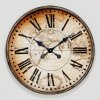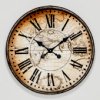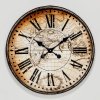Felix_Silvetris
New Member
- Messages
- 4
- Likes
- 0
Hi!
I have a dilemma with a high resolution picture that I want to use on a large screen. The problem is the screen has a low resolution which seem to distort the picture sometimes. Also I would like to zoom in the picture.
The monitor is a 47 inch HP LD4720tm sporting a 1,920 by 1,080 resolution. So the resoultion is like an ordinary desktop monitor but the size is more than double that. In other words, the pixel density (ppi) is much smaller.
The picture is of a clock. Size is about 670X670 pixels. I cropped out this clock from a larger 12MP Raw format Nikon picture. The cropped out clock looks something like this (my real image is copyright protected but this is very similar with 700x644px):

(http://www.stanleylondon.com/ClockShipsBellSml1.jpg )
On the screen this picture should take up a fixed size of 170X170 pixels (ie about 10% of the monitor).
The first way I did this was to simply in Photoshop Elements save the 670X670 picture as a png and with dimensions 170X170 pixels. ("Save for web" to get it as small in size as possible and chose png and 170X170). Then I put the 170X170 pic on the background canvas. It looks very nice. However, when I zoomed in the numbers and other details look very jagged or blurry.
So now I tried with the larger resolution 670X670px. I put this on the background too, and as it should only take up 170X170px, I clicked it and dragged to resize it. But this picture looks much worse than the 170X170 pic. I suppose the 170X170 pic perfectly fits the 170X170 space while the 670X670px is distorted. I mean, for the 170X170 pic there will be one pixel for each monitor point. When I do the exact same comparison on a 21 inch 1920X1080 monitor they look equally good, so it must be due to the low pixel density of the 48 inch monitor where the human eye can see each pixel.
However, now when I zoom in the details for the 670X670px were clearly visible.
I tried a few other resoultions like 360X360 and 270X270 (I resized the 670X670 pic to these sizes) and both png and jpeg. They also looked worse in normal view but of course in zoomed view they displayed more details than the 170X170 pic.
My dilemma now is how to get an image that will look good both when zoomed in and when in 100% zoom (normal view) on this large screen. Is there a way to do this. Eg like resizing to a resolution larger than 170X170 that will also look good in normal view.
Thanks.
I have a dilemma with a high resolution picture that I want to use on a large screen. The problem is the screen has a low resolution which seem to distort the picture sometimes. Also I would like to zoom in the picture.
The monitor is a 47 inch HP LD4720tm sporting a 1,920 by 1,080 resolution. So the resoultion is like an ordinary desktop monitor but the size is more than double that. In other words, the pixel density (ppi) is much smaller.
The picture is of a clock. Size is about 670X670 pixels. I cropped out this clock from a larger 12MP Raw format Nikon picture. The cropped out clock looks something like this (my real image is copyright protected but this is very similar with 700x644px):

(http://www.stanleylondon.com/ClockShipsBellSml1.jpg )
On the screen this picture should take up a fixed size of 170X170 pixels (ie about 10% of the monitor).
The first way I did this was to simply in Photoshop Elements save the 670X670 picture as a png and with dimensions 170X170 pixels. ("Save for web" to get it as small in size as possible and chose png and 170X170). Then I put the 170X170 pic on the background canvas. It looks very nice. However, when I zoomed in the numbers and other details look very jagged or blurry.
So now I tried with the larger resolution 670X670px. I put this on the background too, and as it should only take up 170X170px, I clicked it and dragged to resize it. But this picture looks much worse than the 170X170 pic. I suppose the 170X170 pic perfectly fits the 170X170 space while the 670X670px is distorted. I mean, for the 170X170 pic there will be one pixel for each monitor point. When I do the exact same comparison on a 21 inch 1920X1080 monitor they look equally good, so it must be due to the low pixel density of the 48 inch monitor where the human eye can see each pixel.
However, now when I zoom in the details for the 670X670px were clearly visible.
I tried a few other resoultions like 360X360 and 270X270 (I resized the 670X670 pic to these sizes) and both png and jpeg. They also looked worse in normal view but of course in zoomed view they displayed more details than the 170X170 pic.
My dilemma now is how to get an image that will look good both when zoomed in and when in 100% zoom (normal view) on this large screen. Is there a way to do this. Eg like resizing to a resolution larger than 170X170 that will also look good in normal view.
Thanks.





